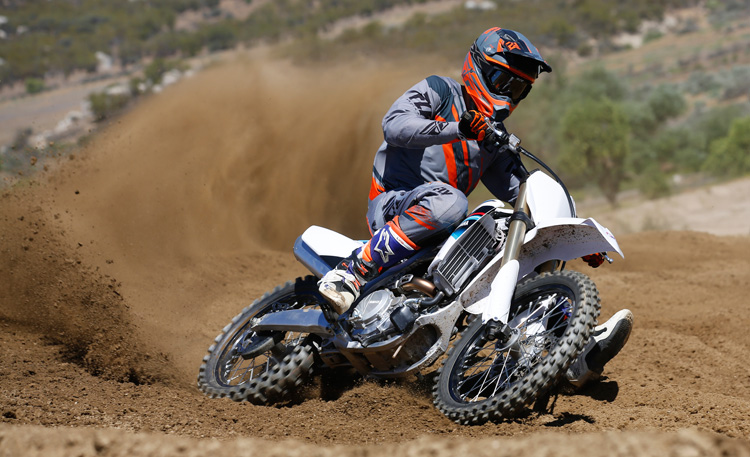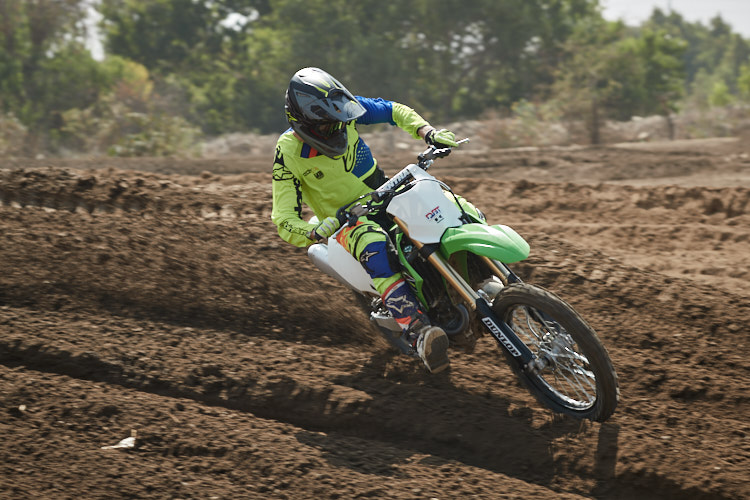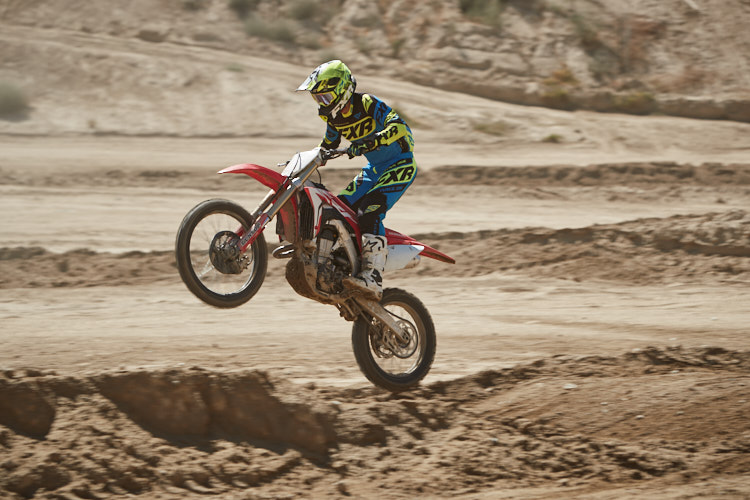Name: Ryan Nitzen
Age: 23
Ability: Moto Intermediate
Years Riding: 15
Height: 6’1″
Weight: 175 lb.
Personal Rides: 2018 CRF450R
1 – Yamaha YZ450F: This is a bike I could buy off the showroom floor in the morning and line up for a race in the afternoon. At first the YZ feels a little wider than it’s competitors, but it becomes comfortable right away on the track. That “wide” feeling feels very stable, especially in the fast straights and big hills at Glen Helen. Yamaha’s suspension is my favorite of the class as it’s plush on top and maintains that cloud-like feeling even in the rough stuff. The pegs are wide enough to feel like an aftermarket set and provide a comfortable platform for the rider. I liked the standard map and alternate (smooth) map for the tracks we rode and the Power Tuner App made it easy to make these changes on the fly. Yamaha’s updated seat foam might seem like a small change but it is very noticeable for the rider. The overall package of power, suspension, and rider comfort make this bike a winner for me.
2 – Kawasaki KX450: The green machine was just shy of being the best in the class, personally. This all-new machine has the most changes for 2019 and it shows. The new e-start and hydraulic clutch are some of the most noticeable changes right off the bat, but the handling and power come to life the second it hits the dirt. The motor pulls strong through the rev range, starting with a torquey low-end hit before quickly burning through rpms up to its redline. The handling was superb as it tracked just as well around the fast outsides as it did in the slower flat turns. I felt like I was able to steer with the power of the rear wheel while the shock ate up the bumps with ease. I positioned the handlebars in the rear setting and raised the forks 2mm to get more ability to “turn” with the front end. I had no real complaints with the KX and found it very comfortable from the first lap to the last.
3 – Honda CRF450R: The red ride is like a dragon that breathes fire and emits it fury in the same color as its shroud covers–RED . With some of the strongest power in the class, it forces the rider to stay alert and makes them feel like Ken Roczen on the track. I preferred Map 2 on the Honda as it smoothed out the power delivery and made it easier to ride in nearly every situation. The smoother map allowed the power to ease on as opposed to the harsher “hit” found in the other maps. As expected, the handling was one of the best. I felt like wherever I looked, that’s where the bike went. It was stable in the straights and felt light and agile in the tight corners. The new pegs and Renthal Fatbar provided a more comfortable rider cockpit and allowed me to ride longer with less fatigue. With two mufflers, the Honda does sound loud while riding, something I noticed over the other bikes in the class. I took a few clicks out on the compression during the afternoon at Glen Helen and it ate up the braking bumps as easily as it tore up the fresh track at Milestone.
4 – Husqvarna FC450: Here’s where it gets difficult. The Husqvarna might seem like a white KTM on paper, but on the track it was a different story for me. The air fork on this bike felt surprisingly planted in all areas of the track and never felt too harsh or “air forky”. What I really liked about the Husky was the Traction Control feature. The hills at Glen Helen can bring out the best or the worst in a bike and the TC shined in the technical off-camber insides. I felt like I was able to corner with confidence and wasn’t worried about the rear end breaking loose. The power on the Husky is unique as it revs higher than the Japanese bikes. If you ride the Honda and Yamaha at 6k RPM, then it feels like you’d ride the Husky at 8k. That being said, the power up Mount Saint Helen’s was one of the best. I could leave it in third gear all the way up the hill, as opposed to shifting mid-way up on the Japanese bikes. The handlebars and composite subframe seemed to be more forgiving over it’s orange brother, which is why I ranked it higher on the list. The hydraulic clutch and brakes were another highlight while my only dislikes were the subframe mounts feeling wide in the boot area and the seat being “too grippy” if that’s a thing.
5 – Suzuki RMZ450: The do-it-all machine. The Suzuki does everything well, but nothing great. It is not low on my list due to any dislikes, rather the other bikes just did it better. This bike had strong and smooth power that was manageable and fun in every rpm range. The forks felt a bit stiff at first, but 2 clicks softer on the compression made it much more forgiving. The Suzuki’s handling is very nimble as it feels narrow and definitely “turns” with the front end. I really liked the modulation and of the front brake but disliked the kickstarter in a field of e-start 450’s. If you are a novice / early intermediate rider and don’t mind kicking, this is the bike for you.
6 – KTM 450SX: The KTM was great, but when we’re forced to pick these bikes apart to a fault. I never got totally comfortable on the Katoom as it felt much different than the Japanese bikes I’m used to. The rider cockpit feels very flat and low to the ground; like the area from the gas tank, seat, and rear fender are one flat shape. For me, I felt like I was riding “on” the bike versus “in” it. The power of the KTM is very similar to the Husky where it revs higher and feels almost like a 2 stroke or a 350. The brakes and hydraulic clutch were a definite plus for me, as well as the bike feeling noticeably light on the track. However, the pegs and brake lever / pedal were pitfalls in my book. The pegs felt long and narrow and kept grabbing my boot in times where my foot was dangling by the peg. The suspension was again similar to the Husqvarna and felt smoother than expected, especially being an air fork. In no way was this bike “bad”, it would just take more getting used to for me.




